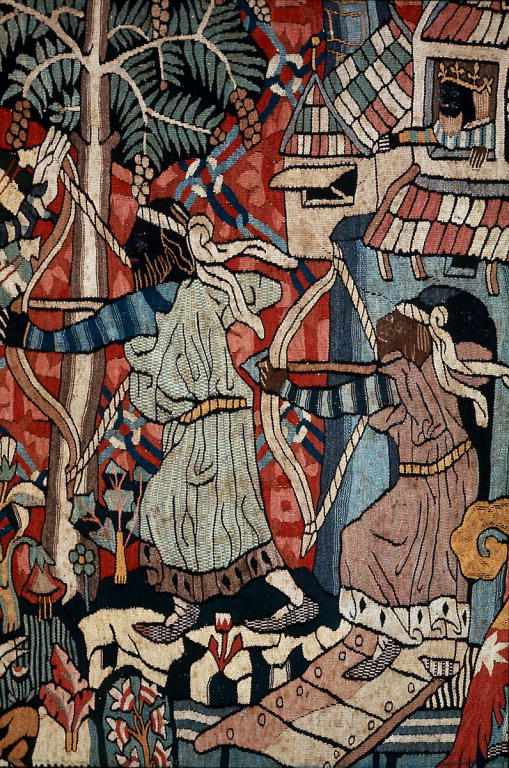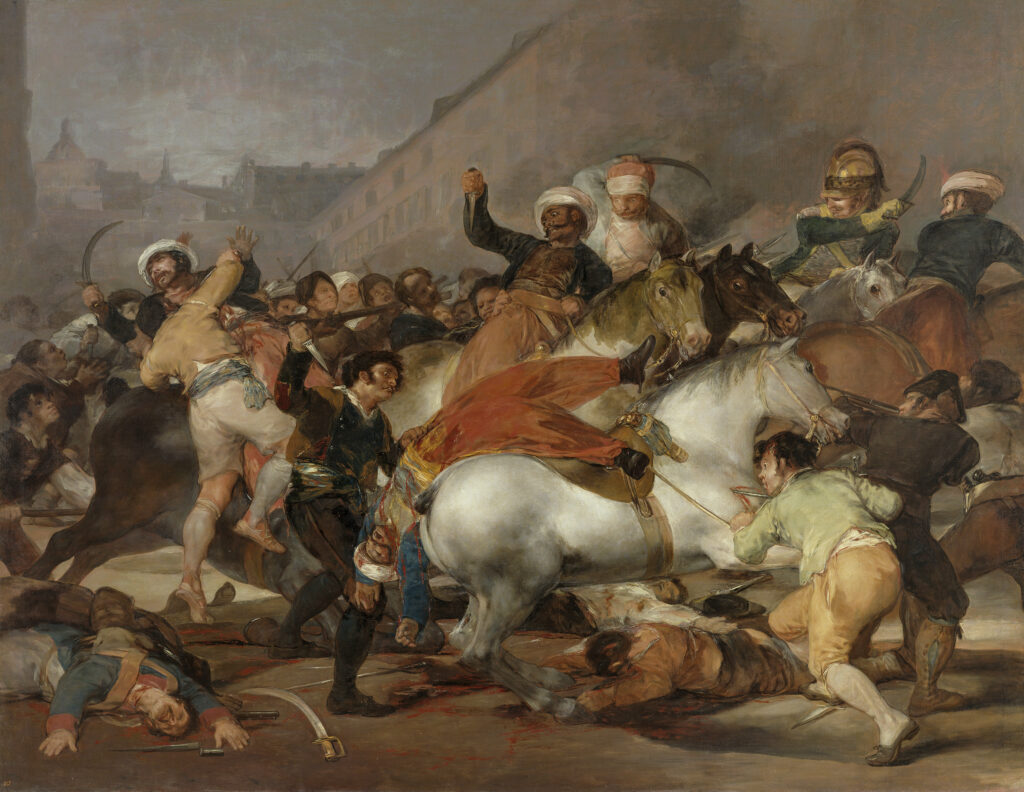Colour (and culture) clashes
ROBERT HENDERSON reviews a global survey of racial and cultural confrontations
Ethnic Conflicts
Tatu Vanhanen, Ulster Institute for Public Research, 326 pps, £23 hb, £18 pb

Detail of Wild Men and Moors tapestry CA 1440
This is not a book designed for easy bedtime reading. It is an academic’s work written first and foremost for academics with a fair amount of statistics in it. Having said that, if a prospective reader managed to get to grips with, say, The Bell Curve they should be able to absorb the important messages of Prof Vanhanen’s book and understand how he arrives at them. It is worth making the effort because he deals with the most fundamental sociological aspect of being human: how do we manage the challenges produced by heterogeneous societies?
The Professor’s first aim was to measure the relationship between the ethnic heterogeneity of a society and ethnic conflict. There are considerable difficulties in doing this, not least because what may be thought of as ethnic conflict by one person may be seem by another as conflict based on something else such as class. For example, an ethnic group which is black and poor and rebels against the better off in society who are white (a not uncommon state in Latin America) could be represented as being either ethnically motivated or class motivated.
There is also the general problem of what constitutes ethnicity. Prof. Vanhanen’s definition is very broad and includes racial type, nation, tribe, language and religion. While these are undoubtedly all distinctions which cause people to exhibit what might be loosely called tribal behaviour, its breadth does raise the question of whether racial type, nation, tribe, language and religion are really comparable in terms of how people respond to those inside and outside the group. For example, it may be that where the ethnic division is one of religion between those of the same racial type and general culture representative government will mitigate ethnic tensions – while if the division is racial, representative government may do nothing to stop discord.
There is a further cause for confusion in that more than one of Prof. Vanhanen’s ethnic criteria are frequently shared by an ethnic group or even more confusingly by two conflicting ethnic groups. Muslims are a good example. In theory there are meant to be no distinctions between Muslims on the grounds of sectarian allegiance, racial type, tribe or nationality. In the real world, there are marked divisions within the theology of Islam and tribal and national allegiances which often override the supposed unity of Muslims. The danger with the very broad definition the Professor uses is that the process of defining reduces the world to so many different ethnicities that it becomes difficult to distinguish between ethnic conflict and non-ethnic violence which he ascribes to the “endless struggle for permanently scarce resources”.
Having made those qualifications, of which Prof. Vanhanen is well aware, the project does not utterly founder on them. It is a mistake to imagine that nothing valuable can be gleaned from using criteria which have a fuzziness about them. That is especially so if the sample is large enough because a large sample in social science projects digests anomalies. As there are few societies now which do not have some basis for significant ethnic conflict the Professor is able to cast his net very widely amongst 176 countries, around nine-tenths of those currently existing.
But the Professor wants not only to test whether ethnic heterogeneity is correlated with ethnic conflict; he also wishes to see if ethnic nepotism is a driver of ethnic conflict –
My argument is that ethnic cleavages divide the population into groups that are, to some extent, genetically different.
The concept of ethnic nepotism is based on the idea that it is an extension of family nepotism, that those belong to the same ethnic group favour those within the group over outsiders. (It is important to bear in mind that Prof. Vanhanen does not claim that ethnic nepotism is the cause of all group-based conflict, merely that it explains why conflict in many societies is so often based on ethnic divisions).
To test this hypothesis, Prof. Vanhanen devised his own scales of ethnic heterogeneity and ethnic conflict and compares them with non-ethnic measures devised by others, such as the Human Development Index and The Index of Democratisation. He found only weak correlations between the non-ethnic measures but a strong correlation between ethnic heterogeneity and ethnic conflict (p214). In other words, his research suggests that the greater the ethnic diversity in a society the greater the ethnic strife, although there are significant variations between the various traits he includes in his definition of ethnicity.

The Second of May 1808 was the beginning of the popular Spanish resistance against Napoleon.
I have something of a problem with the concept of ethnic nepotism in the context of Prof. Vanhanen’s definition of ethnicity because it includes non-genetic differences such as language and religion. It is true that those who are racially similar will be genetically closer than those who are racially different. It is also true that those who form a large tribe or a nation in the cultural sense will in practice be genetically closer than those outside the group. The possession of a particular language by a group is also a strong pointer to close genetic links, unless there is some obvious difference such as race or the language spoken not as a native would speak it. Religion is more problematic because that is something that can be simply acquired. If a man says he is a Catholic or Muslim it does not necessarily say anything about his genetic connection with other Catholics or Muslims. Nonetheless, if the Catholic or Muslim comes from the same country or even supranational area, there is a decent chance that he will have a closer genetic relationship with other Catholics and Muslims from the area than would be expected purely from chance.
The difficulty is that although a significant genetic linkage will commonly exist because human beings live in groups, whether a small band or a modern nation, it does not automatically follow that genetic similarity is what causes the ethnic nepotism. It could be that the simple fact of growing up with people creates a tribal feeling rather than genetic closeness. Moreover, what are we to make of the “imagined community” of any group where the numbers are too great to allow personal knowledge of all those in the group? I do not doubt that differences of religion, nation, tribe, language and race do act as triggers for the separation of groups in competing entities, but with the exception of race I cannot see that genetic influence is proven to be other than accidental. Where there are divisions in a society based on clear racial lines that is a different matter, because there is self-evidently a genetic cause for the preference for one class of person in a society over another class of person.
The book ignores what I would describe as the most basic ethnic conflict – that is the behaviour of individuals to disadvantage someone of a different ethnicity without there being any deliberate group decision or action. A good example is the grossly disproportionate number of black rapes and murders of whites in the United States. That situation is clearly at least partly driven by racial feelings, with blacks either harbouring a general resentment of whites or simply seeing whites as outside their group and thus not of consequence. However, the latter explanation does not hold much water because blacks do not attack Asians with the same frequency.
Are there remedies for ethnic strife? Prof. Vanhanen suggests four: biological mixing, institutional reforms, democratic compromises and partition. Of these only partition even in theory offers a complete solution to ethnic strife with the prospect of a completely ethnically homogeneous society or at least one in which the minorities are so small as to barely matter. The problem with partition is that it is probably never possible to simply divide a territory because mixed populations are generally not neatly parcelled up in convenient parts of the territory.
By institutional reforms, he means most particularly the legal and democratic structures which ostensibly protect the interests of each ethnic group and by democratic compromises the satisfaction of each ethnic group’s aspirations to at least a point where violence is avoided. The Professor finds some evidence that democratic institutions can reduce the amount of ethnic violence, although he allows that
The willingness of competing ethnic groups to solve their interest conflicts by democratic compromises and power-sharing is limited
The fourth of his remedies – biological mixing – is the one with which I have most difficulty. He claims (p.222) that biological mixing would reduce ethnic violence because it would “undermine the basis and importance of ethnic nepotism”. He further observes
My argument is that the relatively low level of ethnic violence in most Latin American countries is causally related to the fact that racially mixed people constitute a significant part of the population in these countries
I think most people would be surprised at his judgement that there is a “relatively low level of ethnic violence in Latin American countries”. I am very dubious indeed about the idea that many of the conflicts which arise in the region are often not ethnic in origin, using the Professor’s own definitions. To take just one example: amongst those with black ancestry, whether that is wholly black or black mixed with other races especially the white, there is in Latin America and Caribbean a customary hierarchy of colour with the lightest skin signifying standing at the top of the social status ladder and the darkest at the bottom. Look at Brazil as an example. This country is beloved by white liberals as a prime example of a colour-blind country. The reality is that the reins of power and privilege are still held overwhelmingly by whites. The great Brazilian footballer Pele complained publicly about this some years ago.
The likely outcome of biological mixing on any scale would be for those of mixed parentage to find their natural group amongst those from who most resemble themselves. This is actually what happens in practice. In Britain, the children of one black and one white parent almost invariably represent themselves as black. It would at best simply change the balance of races within a society and at worst add to ethnic conflict with those of mixed parentage added to the groups competing within the same territory.
Professor Vanhanen’s overall conclusion is a gloomy one:
The central message of this study is that ethnic conflict and violence, empowered by ethnic nepotism and the inevitable struggle for scarce resources, will not disappear from the world. It is more probable that the incidence of ethnic violence will increase in the more and more crowded world
The moral of this book is beautifully simple: ethnically/racially heterogeneous societies are a recipe for discord and violence. That should give the propagandists of mass immigration pause for thought.
ROBERT HENDERSON blogs at www.livinginamadhouse.wordpress.com











Some proponents of mass immigration actually want “discord and violence”. As a leftist slogan put it at the start, “Here to Stay! Here to Fight!”
The “race, gender, class” subversion of western institutions proceeds with minimal resistance and eventually takes to the streets with impunity.
Fast forward to the BLM in 2020. Si monumentum requiris, circumspice.